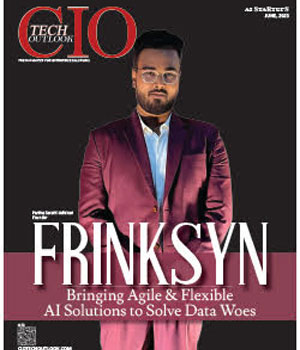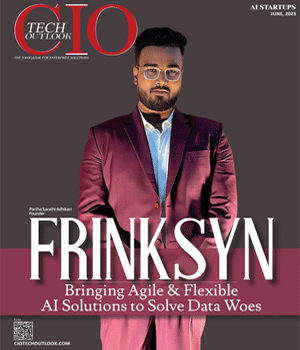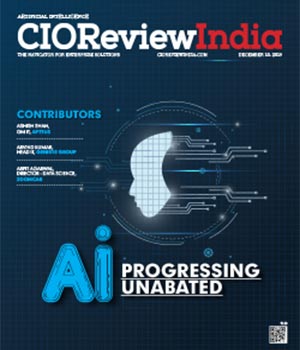
Ensuring Cyber Resilience in an AI-Driven Landscape
Prasad Sabbineni, co-CEO, MetricStream | Wednesday, 22 May 2024, 09:55 IST
 In the business landscape of 2023, generative AI took centre stage across various sectors, marking a significant shift in technological advancement. An EY report suggests that India stands poised to potentially increase its GDP by an impressive range of $359 billion to $438 billion by the fiscal year 2029-2030, attributed to the adoption of Gen AI, surpassing its baseline estimate.
In the business landscape of 2023, generative AI took centre stage across various sectors, marking a significant shift in technological advancement. An EY report suggests that India stands poised to potentially increase its GDP by an impressive range of $359 billion to $438 billion by the fiscal year 2029-2030, attributed to the adoption of Gen AI, surpassing its baseline estimate.
Like in every other sector, AI and Generative AI (Gen AI) is highly valued in the governance, risk, and compliance (GRC) landscape, particularly cybersecurity. Businesses regard Gen AI for its capacity to operate continuously, analyze intricate and diverse datasets, and assist risk leaders in transforming threats into opportunities for advancement.
Gen AI holds particular appeal for risk leaders due to the rapid adaptation required in GRC programs to address evolving risks and changes. With responsive technology, programs can adapt swiftly, prompting significant investments from IT and cyber teams in new AI and gen AI initiatives. These investments aim to bolster defences against escalating cyber threats, keep pace with volatile regulatory landscapesand facilitate the integration of future-oriented technologies like AI.
As organizations integrate AI technology into their cybersecurity programs, some considerations are necessary for internal transformation. Leaders must anticipate these changes and associated advantages as they continue to integrate AI technology in addition to current GRC practices.
Addressing AI Risk: Strategies for Secure Deployment
As organizations strive to remain competitive, they are embracing new technologies and undergoing significant digital transformations. However, these changes bring along unknown risks that must be addressed. Investment decisions such as payment gateway integrations, backend data exchanges, and cloud computing services expand a business’ potential attack surface, necessitating effective risk management.
Among these technologies, AI stands out as a trending topic of discussion in boardrooms, particularly the integration of generative AI into daily operations. The promise of hyper-efficiency entices organizations to understand how predictive modelling and conversational tools powered by machine learning can enhance the customer experience.
However, adopting AI introduces a unique set of risks. The accuracy of AI-generated conclusions depends on the quality and quantity of the data it receives. Unchecked data integrity or inadequate security measures can lead to adverse impacts, including data leakage. Cyber teams must thoroughly understand all AI assets and their potential impacts before implementation and effectively communicate these risks to compliance officers, who seek to establish comprehensive risk assessment frameworks.
Even organizations with a high-risk appetite rely on IT and front-line stakeholders to understand how AI influences the business, particularly its impact on customer interactions. By ensuring thorough comprehension and proactive risk management, organizations can navigate the complexities of AI integration while safeguarding their operations and customer relationships.
Optimizing Data Gathering for Boardroom Success
C-suite leaders and top management know that cyber teams now handle more than just data storage and security. They also tackle increased cyber threats, evolving data privacy regulations, and the need to prevent data leaks by AI tools. This expanded responsibility drives significant investment in cybersecurity.The looming threat of unforeseen events and rising cyber threats such as ransomware have prompted 96% of businesses to enhance their cyber resilience strategies, as per the India Crisis and Resilience Survey 2023.
Cyber risk leaders often present these challenges to the board, emphasizing project performance and ROI impact. To effectively communicate these metrics, it is crucial to use familiar measures like KPIs and discuss potential losses in monetary terms. This reporting approach helps quantify the financial impact of organizational risks, providing the board with a clear understanding of the stakes.
The ability to report impacts in numerical terms—such as potential dollar losses, risk event occurrence percentages, and projected program ROI—remains a priority for CISOs and CSOs amidst expanding technology investments. GRC solutions that facilitate routine disclosure of an organization’s cyber risk posture empower leaders to defend their investments and enhance their long-term risk management strategy.
Maximizing GRC Efficiency
A key challenge cyber risk program leaders face is addressing inefficiencies in their GRC programs to enhance cost-effectiveness in planning and reporting, particularly in organizations that underwent right-sizing in the last year. For an organization looking to maximize its existing GRC solution to ensure compliance while focusing on future needs, the answer lies in optimizing its GRC.
GRC programs continue to evolve, offering increasingly dynamic products and capabilities that deliver immediate value and substantial cost savings. The latest solutions leverage AI to extract insights from diverse platforms and existing customer data, enabling organizations to enhance their GRC without needing new platform purchases or migrations.
These cognitive insights expand what GRC can achieve for a business. AI-powered GRC facilitates advanced threat detection, predictive analytics, and real-time regulation monitoring, supporting compliance controls. The goal is not to replace existing systems but to optimize them by integrating intelligent solutions that enable comprehensive data collection and decision-making across the enterprise.
However, achieving cyber risk objectives requires a deep understanding of deployed technologies and communicating their impacts and outcomes to compliance officers and senior leadership. Effective governance, ideally through centralized tools and processes, is essential to manage risks and ensure proper documentation, control, monitoring, and treatment. Providing a good mix of innovation and risk control is vital when using generative AI responsibly.
Generative AI: Reshaping GRC Landscape
The coming years look promising for risk leaders, even those cautious about adopting new tech. Generative AI transforms GRC by automating tasks, analyzing regulations, predicting risks, and improving compliance strategies. Real-time monitoring and audits are more straightforward, too.
However, it is essential to recognize that generative AI offers great possibilities in GRC but also brings challenges like bias mitigation, regulatory compliance, ethical use, data privacy and security. GRC practices for AI are still evolving, with regulators working to establish guidance and frameworks for its ethical and lawful use.
Organizations with a unified GRC approach will find compliance easier. Continuous monitoring tools identify risks and control deficiencies in real-time, prioritizing risk assessments for better defence.
Navigating these complexities requires balancing automation with human oversight. A proactive approach incorporating ethical frameworks, diverse data sources, strict privacy measures, and continuous monitoring is essential. Achieving this balance will enable organizations to leverage generative AI effectively and responsibly for GRC practices.
CIO Viewpoint
Harnessing the Power of AI and ML for Business...
By Vinod Subramanyam, Managing Director, Brillio
The Key to Achieving Real-time AI: Optimizing...
By Mukundha Madhavan, APAC Tech lead, Datastax
Smart Payment Solutions: The Role of AI and IoT...
By Manoj Varma, Head - Payments, Lyra Network, India
CXO Insights
Leveraging AI for Insurance Penetration in...
By Shwetabh Walter, Chief Product Technology Officer, PB Partners
Impact of Generative AI on Ceramics Manufacturing
By Manish Chandegara, CIO, Simpolo Ceramics
Understanding the Impact of Gen AI on the BFSI...











.jpg)
.jpg)
.jpg)







